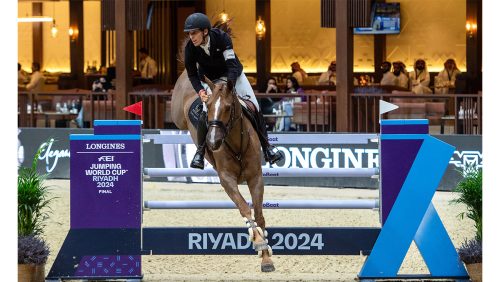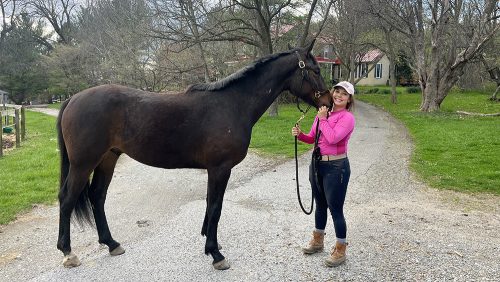So, what exactly IS that SFN prefix before the name of Jeroen Dubbeldam’s team and individual gold medal horse at the FEI European Championships, SFN Zenith NOP? It’s an innovative strategy the Dutch are employing to keep some of the country’s best horses jumping on their teams, not for other countries.
In the Chronicle’s Sept. 22, 2014 World Games print magazine coverage about Jeroen Dubbeldam and SFN Zenith NOP claiming team and individual gold at the 2014 Alltech FEI World Equestrian Games, we looked into how the Dutch are seeking to keep good horses jumping in orange. SFN Zenith NOP is their poster child, with his back-to-back double gold medals in the World Games and European Championships.
In a roundabout way, the Dutch show jumpers owe a little something to the United States for their double-gold medal performance at the Alltech FEI World Equestrian Games in 2014 and at the 2015 FEI European Championships.
In 2005, five U.S. riders and a barn full of Dutch Warmbloods trounced everyone on the showgrounds at La Baule CSIO (France). Georgina Bloomberg (Riviera), Beezie Madden (Judgement), Schuyler Riley (Ilian) and Laura Kraut (Miss Independent) won the Nations Cup, while the Dutch team finished seventh on a dismal score of 45. To add insult to injury, Anne Kursinski, Bloomberg and Kraut won several other classes, all on other Dutch-breds.
Dutch journalist Jacob Melissen had been musing about the problem of keeping top Dutch horses in the Netherlands for a while, and during the dark, 10-hour drive home from La Baule, he started to come up with an answer. As soon as he got home, he drafted a column outlining his idea for the Dutch magazine Hoefslag. Then he invited the biggest horse dealers in the country and the treasurer of the Dutch Equestrian Federation to dinner to pitch his plan for a patriotic syndication model that could help keep the best horses in the country.
“I told them, look where you came from, and look where you are now,” said Melissen. “You’re all really rich people, and you started out poor, and it’s all thanks to equestrian sport. I think it’s payback time.”
The reaction was very positive, and they founded the Springpaarden Fonds Nederland, or SFN, i.e. The Showjumping Fund of the Netherlands. The fund works hand-in-hand with breeders, dealers and the Dutch Federation as they buy horses for Dutch riders. SFN buys the horse at a lower rate, as the original owner keeps a 25 percent stake in the horse. The original owner earns a share of prize money and profits from sold horses but forgoes the rest of the decision-making process about the horse’s career.
SFN’s charter clarifies that horses between the ages of 8 and 12 at the four-star level or higher shouldn’t be sold to foreign parties but rather aimed toward major international games. But it’s not a charity. For example, the fund had promised to keep Utascha SFN—a cornerstone of the Dutch team under both Eric van der Vleuten and Jeroen Dubbeldam—through 2012, and they didn’t sell her until December of 2013 at the end of her 12-year-old year. This marks the fourth time in five years that an SFN horse competed at an international championship.
ADVERTISEMENT
Dutch riders approach the SFN with a proposed horse to purchase, and the selectors—Willy van der Ham, Johan Heins, Emile Hendrix, Egbert Schep and Teus van den Brink—weigh in. The fund currently owns nine horses ranging in age from 5 to 11.
“The biggest secret is that these five selectors are absolutely independent,” said Melissen. “When one thinks a horse is fantastic and the others don’t agree the horse isn’t purchased for that amount, or isn’t purchased at all. They’re correcting for each other.”
Dubbeldam had approached SFN about Zenith in early 2011. They arranged for Dubbeldam to try the horse for a few weeks, and when it proved a good fit SFN purchased it for him. They were originally aiming the horse at the 2016 Rio de Janeiro Olympic Games, but he’s already proven a Dutch asset well ahead of schedule.
SFN’s success isn’t lost on the Netherlands. Melissen, who serves as one of the fund’s managing directors, arrived to his home in Pesse, Drenth, [after the Alltech FEI World Equestrian Games in 2014] to find a bouquet from the Dutch National Federation congratulating him on Zenith SFN.
“One of the nicest things is that it’s created a real community,” said Melissen. “We planned a party for all of our stakeholders on Oct. 4 to celebrate after the Games. Everyone’s going to Jeroen’s farm, from the grooms to the shareholders and the media. We planned this three months ago—and who would have known we’d have such a successful weekend.”
In-depth discussion about what goes into creating winning performances are the hallmark of the Chronicle’s coverage in the pages of The Chronicle of the Horse print magazine. You may know who won, but do you know why and how? That’s what we tell you in the magazine…
















